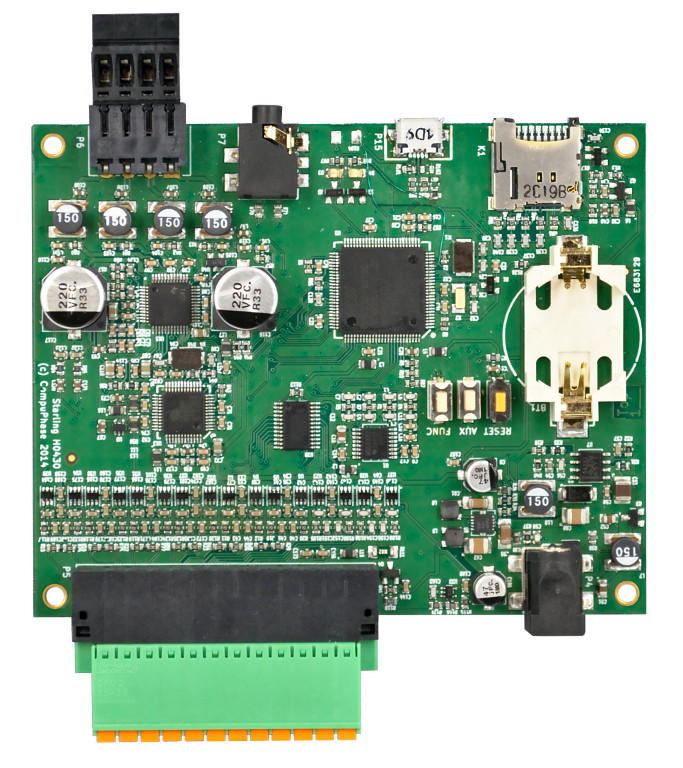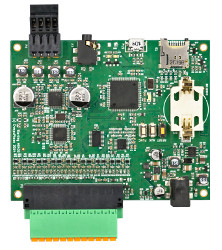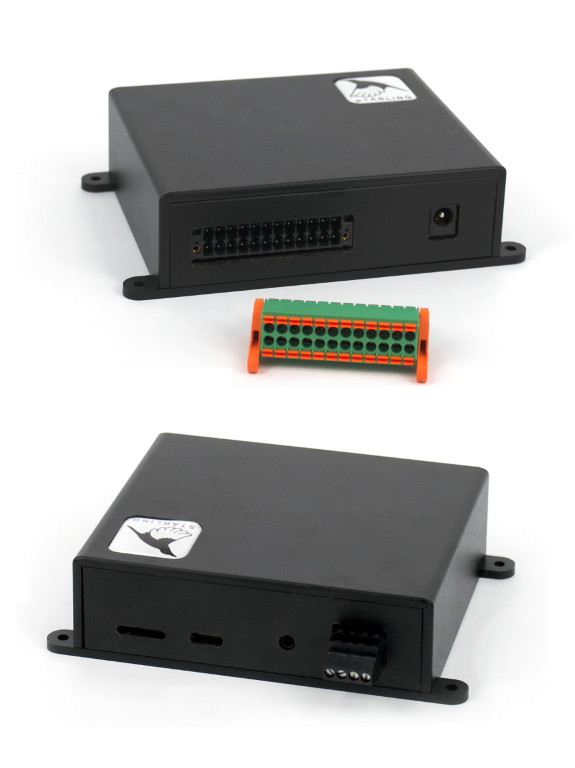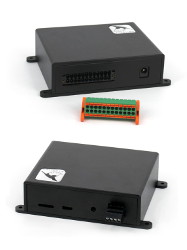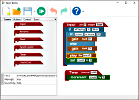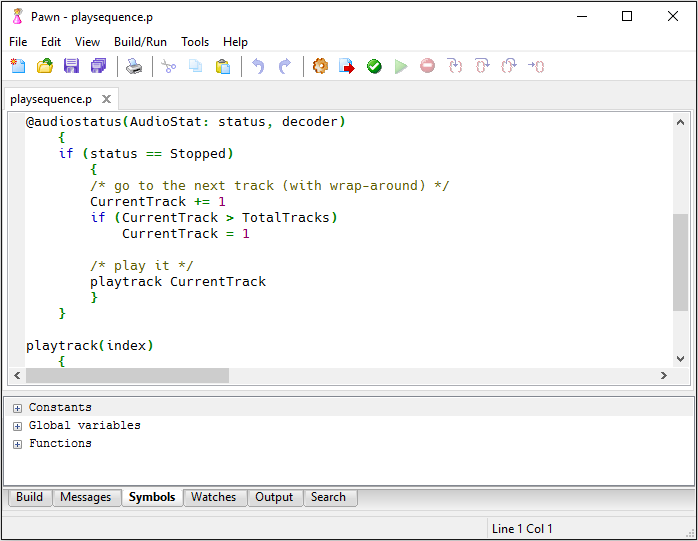 Starling audio player, model H0430
Starling audio player, model H0430

For quotation requests or technical information, please contact us by e-mail. To visit us, see the address information page.
For use in scale models, kiosk applications and public address systems, the Starling audio player provides high-quality audio under control of a switches, sensors & detectors, digital I/O and/or computer interfaces. The control is highly customizable by the use of a “script”.
Model H0430 of the Starling series embeds an efficient class-D amplifier that provides 2 × 15 Watt on 4Ω speakers. The amplifier is highly efficient and it requires no external heatsink.
As mentioned, the Starling audio player interfaces to external electronics, which can range from a mere few switches and/or LEDs, to a slave micro-controller that communicates with the Starling through a parallel or serial bus. Connecting the Starling to a PC or other peripheral, via RS232 or USB, is another option. The functionality of the control logic on the Starling player is fully scriptable (read programmable) in the pawn language.
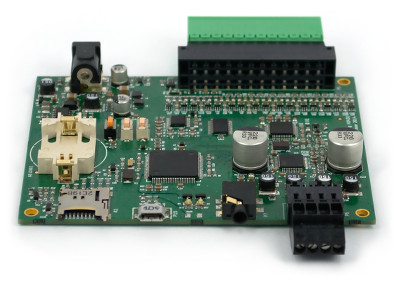
Overview
 A brief User Guide of the Starling model H0430
with a summary of features, installation instructions and an introduction to
programming, dated 2023-10-18.
A brief User Guide of the Starling model H0430
with a summary of features, installation instructions and an introduction to
programming, dated 2023-10-18.
 The data sheet of the H0430 audio player/controller
and usage notes, dated 2016-07-05.
The data sheet of the H0430 audio player/controller
and usage notes, dated 2016-07-05.
- A list of application notes including reference material for programmers.
Features
For details on the features that are listed below, please see the data sheet of the product (2016-07-05), as well as the references at the bottom of this page.
- Solid state design.
- Easy to embed in consoles, scale models or kiosks, due to it small form factor, conveniently placed mounting holes and industry-standard connectors.
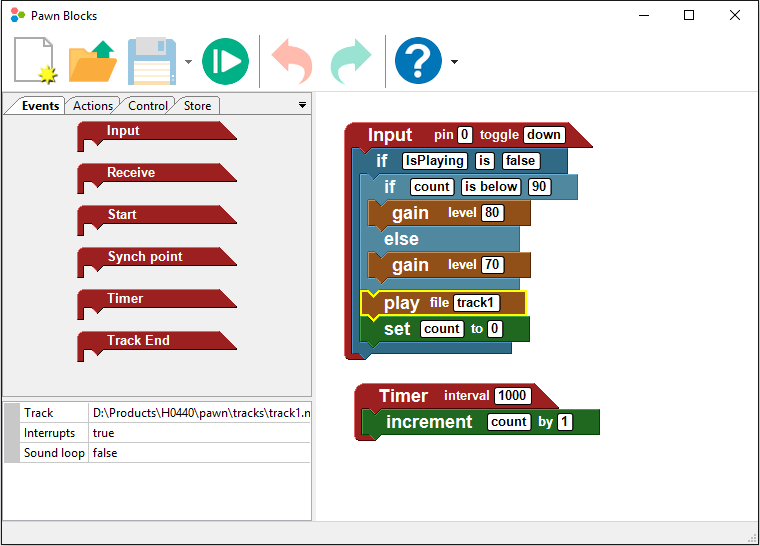 Easy to program through pawn Blocks Designer,
or the the pawn IDE (integrated development environment). The Starling controller
also comes with a set of configurable, ready-to-run scripts for a range of
applications.
Easy to program through pawn Blocks Designer,
or the the pawn IDE (integrated development environment). The Starling controller
also comes with a set of configurable, ready-to-run scripts for a range of
applications.
- Hardware decoder for MP3, Ogg Vorbis and uncompressed PCM.
Decodes MPEG Layer 3, supporting all MPEG sampling frequencies and bitrates, including variable bitrate and the very low bitrates of the MPEG 2.5 extension. - Efficient class-D amplifier, providing up to 2 × 15 Watt power output, plus a combined headphone/line-out connector (3.5 mm TRS jack).
- Volume and tone control, plus separate gain control for the power amplifier. Integrated VU-meter for measuring the audio volume out of the decoder.
- 16 general purpose inputs/outputs (I/O pins), individually configurable. An optional "debounce" filter can be configured for each pin, to debounce switch or relay contacts. The I/O voltage (2.5V to 5.0V) is configurable for pins configured as output. The I/O pins can directly drive a low-power LED or a solid-state relay.
- 1 analogue output, software-controlled.
- USB interface (the USB interface functions as a virtual COM port).
- Dual serial interface (RS232 with software handshaking).
- SPI interface with automatic "slave select" line; configurable SPI mode (CPHA & CPOL) and frequency.
- Integrated temperature sensor.
- Real-time clock with backup battery.
- Two general-purpose on-board switches, two general-purpose on-board LEDs.
- The audio data is read from a micro-SD card. The Starling supports FAT16 and FAT32, and nested subdirectories.
- The Starling parses the ID3 tag (version 2) with support for Synchronized Lyrics, for Karaoke or for synchronizing events to MP3 music. The APE tag is also supported.
- Gapless and clickless sound loops are possible with this audio player.
- General file input/output to the micro-SD card is supported, for logging usage, storing configuration settings, or other applications.
- Supports encrypted MP3 audio tracks; the players can be ordered with a unique 128-bit key and the matching encryption software.
- Wide input power range: 7.5 V to 28 V DC, using an efficient on-board power converter.
- Industrial temperature range: -40 °C to +85 °C, suitable for out-door use.
Typical use of the Starling audio player/controller is inside an object or apparatus where high quality audio is needed in a small and robust package. Due to its temperature range, the Starling is suitable for outside use. As it is low energy and produces little warmth itself, it requires no ventilation. Being solid-state, it can be operational in moving or mobile objects. The player is easily embeddable in other apparatus through industry-standard electronic interfaces.
The Starling is programmable, which implies that it is fully configurable. It can respond on various inputs: switches, digital I/O, RS232, SPI. Similarly, it can drive various outputs: TTL-logic, LEDs, opto-couplers, solid-state relays, or equipment branched onto the RS232, the SPI or the digital I/O bus. Audio fragments may be selected based on various criteria that you put in the programmed script. You can abort sound that is playing, or glue together various fragments. You may also synchronize the audio to the external events based on an internal high-precision timer.
The pawn "embedded scripting language" on which the Starling controller is based, is a quick and small language whose basics can be learned in a few days —or a few hours if you already know C/C++. The language has the event-driven programming model built-in and through the direct support for events, the pawn simplifies the construction of reactive/interactive systems.

The Starling controller parses the ID3 tag (version 2) or the APE tag in the audio track, if present. An ID3/APE tag is an attachment to an audio file that contains additional relevant information about the audio file, for example: the title, the album name, the artist and/or band, the composer, etc. The ID3 tag can contain synchronization points in the track (to synchronize events with a particular spot in the track). The APE tag can contain cue and segue times for head-to-tail scheduling of tracks (and cross-fading), without cropping the tracks themselves.
In some applications, you may wish to protect the audio content from being copied off the SD card onto notebooks, PCs or retail audio players. The Starling offers protection by allowing you to encrypt MP3 tracks with a strong encryption algorithm, using a 128-bit key. The key is embedded in the firmware of the Starling, and the firmware is "read-protected" itself. In other words, the key is never transferred to the Starling and it is not stored at any location that is accessible from the outside. A customer can request a unique 128-bit key upon ordering the Starling, and optionally enhance this with an additional password that the customer chooses him-/herself. Please contact us to register a unique customer key, or to get more information on this application.
The CD-ROM that comes with the Starling contains several applications and software tools for configuration, programming and controlling the player/controller. The two (miniature) screen grabs above are of "Script generator", a visual programming utility to build scripts from blocks, and the programmer's IDE for pawn (for power users and programmers). Please click on the images to zoom in.
Applications
Due to its programmability, the Starling audio player/controller is a flexible fit in many designs. Below are a few examples, but this list is by no means exhaustive (see also the application notes at the end of this page for more ideas).
- Use switches to select tracks and settings: either one track per switch or have switches to move forward and backward through the tracks; a switch press can start playing a track, or the device may keep playing as long as a switch is being held down. You may also choose to play a random track, so that the audio effect is different each time that a user pushes the buttons.
- Instead of switches, use digital input to control the Starling. This input can come from other apparatus or controllers, or from sensors (e.g. proximity sensors). Alternatively, you can link the Starling to an "appliance module" (e.g. for the X-10 protocol) for home automation and domotica.
- With a bar-code scanner on the RS232 connector, tracks may be selected on the basis of bar-codes printed on badges or tickets, in addition, perhaps, with other criteria such as button presses. We have also connected low-cost bar-code wands (pen scanners) directly on the digital I/O lines.
- The RS232 port also allows connection to many other devices, such as computers, ticket printers and professional audio equipment.
- With minimal extra components (an IR-receiver chip and a pull-up resistor), you can use a remote control to change tracks or adjust settings on the device. As the analysis of the IR-protocol happens in software, it can be adjusted to any protocol and any remote control.
- The Starling model H0430 can communicate with a PC (and synchronize its sound effects with a PC-based presentation) via the USB interface.
- Activities, such as turning on LEDs or other equipment via its digital I/O pins, can be synchronized with time stamps embedded in an MP3 track.
References & further reading
Product documentation
- Starling Audio Player, model H0430 - User Guide
- This is the booklet that comes with the product and introduces its features and its programming interface.
- The data sheet of the Starling controller, model H0430
- The data sheet and usage notes, in PDF format. (Date: 2016-07-05).
- Starling Programming Guide & Reference
- The programmer's reference of the Starling (models H0430 and H0440), describing all functions and pawn language features available on the Starling player/controller. (Date: 2020-04-03).
- CE declaration
- The declaration of conformance to the CE norms (EMC, safety and RoHS) as a multilingual document.
- pawn: embedded scripting language
- The pawn scripting language is fully described at its own page.
Application notes
- Synchronizing activities with music
- 2018-03-05
An ID3 tag in an MP3 track may optionally contain text or commands with time stamps. These time stamps allow the text or the commands to be synchronized with the music. The Starling supports this extension, and the article gives a complete example implementation. - Gapless looping MP3 tracks
- 2020-11-05
Due to the file format and the algorithm of MP3 tracks, creating a loop without a gap or click is a little involved, especially when using a hardware player. The H0420 and Starling audio controllers can play gapless MP3 audio loops, provided that special software has processed the MP3 track.
Example tracks & processing software are available from this site, as well as a detailed presentation of how it works. - A remote-controlled audio player
- 2018-03-05
Adding functionality to manipulate the Starling with a common remote control only takes the IR-receiver chip and a pull-up resistor, plus a script that interprets the codes sent by the remote control. This article goes into details and provides a general purpose script for RC5 codes (other infrared protocols are supported by modifying the script). - Synchronizing time with DCF77
- 2018-03-05
This article describes how to synchronize the internal real-time clock of the Starling controller on the time signal emitted by the atom clock on the "DCF77" and the "MSF60" transmitters. - Encrypted MP3 tracks
- 2018-03-05
The Starling audio controller is able to play encrypted MP3 tracks directly (without needing an intermediate decryption phase, and so without start-up delay). This article discusses the software and the operations necessary to create MP3 tracks with strong encryption (and how to play them back). - Power-outputs for the programmable audio controllers/players
- 2013-02-11
The Starling controller has digital I/O pins with up to 5V (TTL-level) digital output with a maximum current of 20mA per pin. This note describes how you can get more power (and/or a higher output voltage) from the I/O pins.
Software Tools
- Development Tools, version 1.0.5797 (for Microsoft Windows)
- The IDE, visual designer, pawn compiler and other tools needed for creating scripts for the Starling H0430. The reference guide is included in this set-up as well.
Miscellaneous resources
- ID3 tag specification
- Informal standards, developer information, backgrounders and the history of ID3 tags.
- APE tag specification
- Informal specification of the APE tag (version 2).

